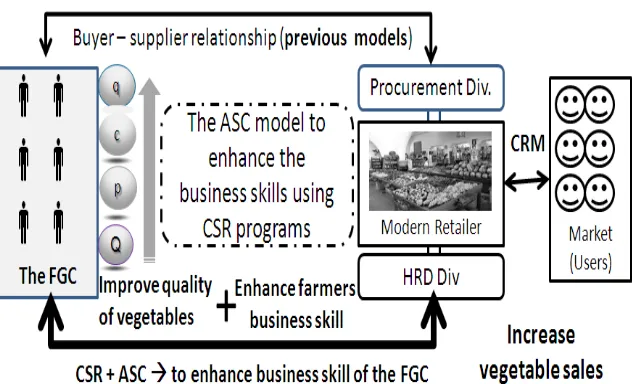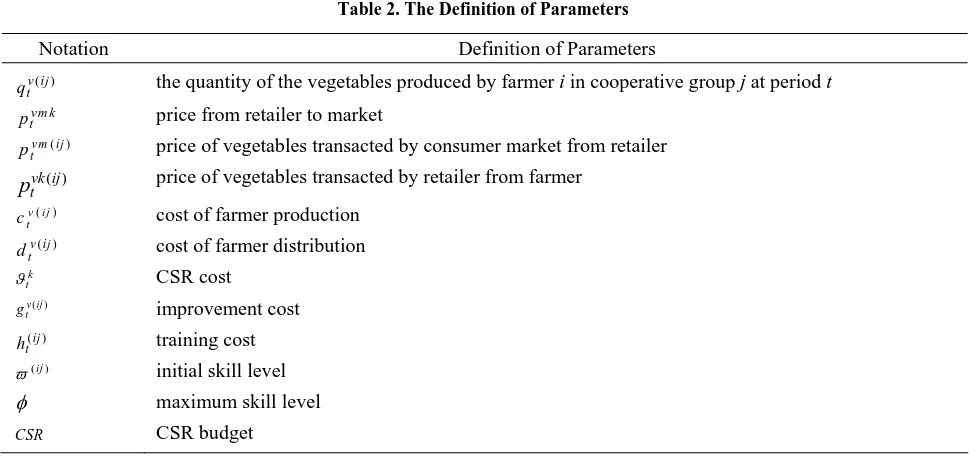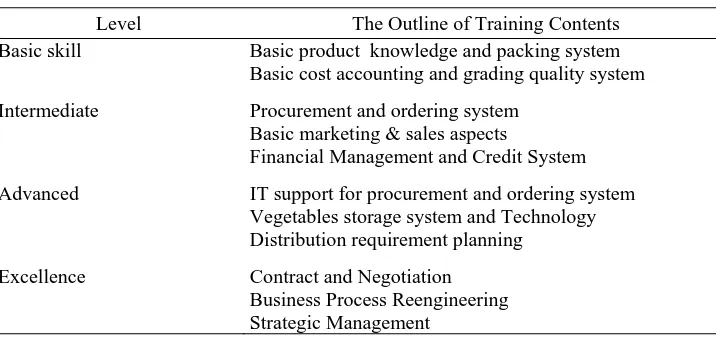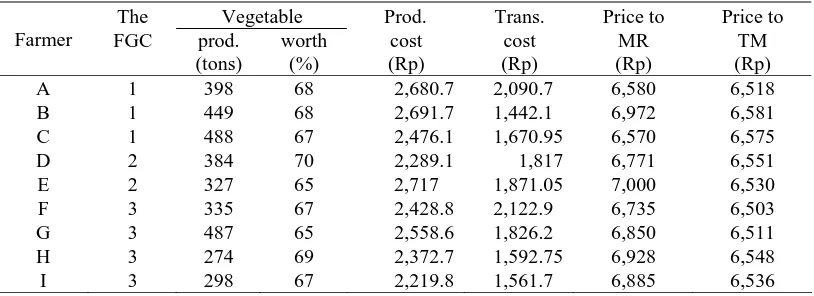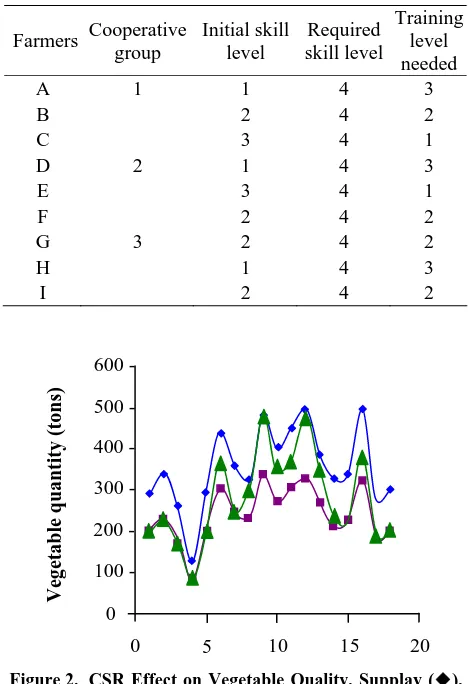43
AN AGRI-FOOD SUPPLY CHAIN MODEL TO ENHANCE THE BUSINESS
SKILLS OF SMALL-SCALE FARMERS USING CORPORATE SOCIAL
RESPONSIBILITY
Wahyudi Sutopo
*), Muh. Hisjam, and Yuniaristanto
Laboratory of Logistics and Business System, Department of Industrial Engineering, Faculty of Engineering, Sebelas Maret University, Surakarta 57126, Indonesia
*)
E-mail:sutopo@uns.ac.id
Abstract
In general, small-scale vegetable farmers experience problems in improving the safety and quality of vegetables for supplying high-class consumers in modern retailers. Farmer Group and/or Cooperative (FGC) should be able to assist its members to meet the relevant provisions of modern retail on product specifications, delivery terms, and internal business requirements. This study proposed an agri-food supply chain (ASC) model that involves the corporate social responsibility (CSR) activities to enhance the business skills of the FGC as supplier of modern retailer. Multi-objective optimization programming is developed to determine the amount and timing of supply, level of farmers training skills, quality improvement target, and the CSR total cost. The results show that the proposed model can be used to determine the priority of programs in order to empower farmers' groups as modern retail suppliers.
Abstrak
Model Agri-food Supply Chain untuk Memperkuat Kemampuan Bisnis Kelompok Tani dengan Menggunakan Aktivitas Tanggung Jawab Sosial Perusahaan. Kebanyakan petani sayur mayur mengalami masalah dalam
memperbaiki keamanan dan kualitas sayur-mayur untuk dipasarkan ke konsumen kelas menengah-atas di pasar modern. Koperasi dan/atau Kelompok Tani (KKT) seharusnya dapat membantu anggotanya dengan memasarkan secara langsung ke perusahaan ritel modern. Penelitian ini ditujukan untuk mengembangkan model agri-food supply chain (ASC) yang melibatkan aktivitas tanggung jawab sosial perusahaan (TJSP) untuk memberdayakan KKT sebagai pemasok pada ritel modern. Aktivitas TJSP dikembangkan untuk meningkatkan keterampilan bisnis para anggota KKT dan memperbaiki kualitas sistem pendistribusian sayur mayur. Model optimisasi tujuan majemuk dikembangkan untuk mementukan varibel keputusan terdiri dari jumlah dan waktu pasokan, tingkat pelatihan yang diikuti, target perbaikan kualitas, dan total biaya untuk aktivitas TJSP. Dari hasil contoh numerik dapat ditunjukkan bahwa model usulan dapat digunakan perusahaan menentukan prioritas aktivitas TJSP dalam rangka memberdayakan kelompok tani menjadi pemasok.
Keywords: agri-food supply chain, business skills, corporate social responsibility, supplier of modern retailer
1.
Introduction
The high-class consumers in modern retailers need high quality and safety of vegetables [1-2]. They are willing to buy the commodities at a higher price to modern retailers. Unfortunately, small-scale vegetable farmers, such as who live around Mt. Merapi in Boyolali Residence, have problems related to their own internal business and market information asymmetry so they cannot supply the commodities to modern retailers [3-4,6-7]. As the consequence, they sell their commodities
Corporations that do business in Indonesia, e.g. modern retailers, must consider environmental and social responsibility in doing thier business [5-6]. As the consequence, the modern retailer must also commit to take a part to improve the quality of life for small-scale vegetable farmers that support their business. Using Corporate Social Responsibility (CSR) programs, corporates can enhance their relationship with suppliers [10,12], and reduce business risks and promoted brand [13-14].
The case described in the previous paragraph can be seen as the integration of key business processes of the integrated system in agri-food supply chain (ASC). The ASC is created by the organizations that responsible for producing, processing, distribution, and marketing the commodities to the final consumers [15]. Thus, it is possible to solve the problem described in the first paragraph by formulating the proper CSR programs for the modern retailers in the integrated system of ASC.
There are number of researches had been conducted to improve supply chain coordination [12], to understand the effect ASC improvements [13], and to make business contracts [16]. Several researchers have attempted to understand the effect ASC improvements [12-13,17], to make business contracts [11,16], and to improve the coordination of buyer-supplier [21]. However, the previous researches did not incorporate any factors which can be considered as particular weaknesses of the small-scale farmers to fulfill the requirements demanded by modern retailers. This study proposes an ASC model that involves the CSR activities to enhance the business skills of small-scale farmers as suppliers of modern retailers.
This paper is organized as follows. In Section 1, we describe the background of our research and describe the real problem. In Section 2, we construct method for developing the model. In Section 3, we provide the results and discussion. In Section 4, we deliver the conclusion and future research.
2.
Methods
ASC network is considered as relevant system of the problem (Figure 1). In the real system, FGC has member of several farmers which plant several types of vegetables and deliver them to the FGC. Then, the FGC sells the vegetables to modern retailer. However due to restrictive quality specification imposed by modern retailer, the FGC must conduct strict quality inspection before it can be supplied to modern retailer. We propose CSR activities conducted by division of human resource development (HRD) of the modern retailer for empowering farmers. The CSR activities are designed to enhance business skills of the farmers and to improve the quality of vegetable distribution system. The objectives of the model are not only to maximize the profit of farmers, but also to maximize CSR benefits for the modern retailer. The decisions of the model are the amount and timing of supply, level of farmers training skills, quality improvement target, and the CSR total cost.
The ASC model can be formulated using the mix integer linear programming (MILP). The notations of indices and sets, parameters, and variables for this model are given in Table 1 to Table 3.
Table 1. The Definition of Indices and Sets Notation Definition of Indices and Sets t∈T period set
i∈I farmer set
j∈J cooperative group set
k∈K modern retailer set
m∈M consumer market set
v∈V vegetable set
Table 2. The Definition of Parameters
Notation Definition of Parameters
( ) v ij t
q the quantity of the vegetables produced by farmer i in cooperative group j at period t
vm k t
p price from retailer to market
( )
v m ij t
p price of vegetables transacted by consumer market from retailer
( ) vk ij t
p price of vegetables transacted by retailer from farmer ( )
v i j t
c cost of farmer production
( )
v ij t
d cost of farmer distribution k
t
ϑ CSR cost
( )
v ij t
g improvement cost
( )ij t
h training cost
( )ij
ϖ initial skill level
φ maximum skill level
CSR CSR budget
Table 3. The Definition of Variables
Notation Definition of Decision Variables
( )
v k ij t
q the quantity of the vegetables transacted by retailer k from farmer i in cooperative group j at period t. km
t
Q the quantity of the vegetables transacted between retailer k and each demand market m at time t
( )ij t
F training taken by farmer i at cooperative groups j in period t
( ) v ij t
ψ quality improvement percentage of vegetable v, farmer i at cooperative group j in period t
3.
Results and Discussion
In multi period ASC model, the modern retailer as the decision maker allocate budget as CSR commitment in order to improve quality of the vegetables delivered by FGC to modern retailer and to enhance business skill of the farmers by providing training. The allocated budget however must be economically feasible for modern retailer to leverage its business objective. The proposed model has two stakeholders, namely the FGC and the HRD Division of Modern Retailer, and each has different criteria.
Multi-products multi-cooperative groups single modern retailer supply chain. The FGC has members
modern retailer. The relationship between the quantity of the vegetables that produced by farmers and that can be sold to modern retailer can be expressed by Eq. (1). Modern retailer sells the vegetables acquired from the cooperatives groups to the consumer. The products flow transacted by consumer is defined as Eq. (2). Eq. (2) expresses the sum of all vegetables sold to customer market less than or equal to the sum of all vegetables bought from all cooperative groups.
( ) ( ), , ,
v ij vk ij
t t
i I k K
q q t j v
∈ ≥ ∈ ∀
∑
∑
(1)( ), , ,
vmk vk ij
t t
m M k K
Q q t j v
∈ ≤ ∈ ∀
∑
∑
(2)The multi objectives decision-making problem of the farmers. Every farmer who incorporates in a FGC
expects maximum profit from its farming activities. Profit is obtained from the total revenue deduced by the total cost. The total revenue is expected from vegetables selling, both to modern retailer and to traditional market. The relevant total cost consists of the production cost and the transportation cost. Thus, the objective of the entire farmers in the cooperative groups can be stated as to maximize Eq. (3). The first term of Eq. (3) expressed the revenue from selling vegetables to modern retailer while the second term expressed the revenue from selling vegetables to traditional market. The first objective of farmers is to maximize the two terms described earlier. The last term presented the total relevant cost that consists of production and transportation cost, serves as the second objective of farmers.
(
)
(
)
( ) ( )
( ) ( ) ( )
( ) ( ) ( ) vk ij vk ij
t t
t T v V k K j J i I
vm ij v ij vk ij
t t t
t T v V m M j J i I
v ij v ij v ij
t t t
t T v V j J i I
p q
p q q
c d q
∈ ∈ ∈ ∈ ∈
∈ ∈ ∈ ∈ ∈
∈ ∈ ∈ ∈
+ −
− +
∑ ∑ ∑ ∑ ∑
∑ ∑ ∑ ∑ ∑
∑ ∑ ∑ ∑
(3)
Modern retailer CSR activities and benefits. The
CSR activities are as follows: in the first period, modern retailer devotes some quantity of money allocated to CSR activities for farmers. The budget is split in two categories, CSR grant for the quality improvement of the vegetables and CSR grant for the skill enhancement of the farmers. Both of the grants are dedicated to farmers.
The first budget serves as a grant to improve the quality of the vegetables produced by the farmers. However due to budget limitation, not all farmers receive the CSR grant. Thus, modern retailer collaborate with the FGC must determine which farmers should receive the grant. The CSR cost for quality improvement then can be defined as Eq. (4).
( ) ( ) v ij v ij
t t
t T v V j i I
g
ψ
∈ ∈ ∈ ∈
∑∑∑∑
(4)The second CSR grant is to enhance business skill of the farmers. Consider modern retailer allocated budget for enhancing business skill of the farmers by organizing management training. First, management skill of each farmer is identified and classified. Then, modern retailer can decide what kind of training level is suitable for each farmer. For example, management skill of farmer 1, 2, and 3 are identified in the level 2, 3, and 1 respectively. Thus farmer 1 requires training level 2 (intermediate), farmer 2 requires training level 1 (basic skill), and farmer 3 requires training level 3 (advance). The maximum management skill is determined by modern retailer, maximum skill level 4 (excellence) is taken as an example. Table 4 lists the outline of training contents that needed to improve the skill of farmer.
Due to budget limitation, the number of the workers participated in training and the training level acquired should be determined. The associated CSR cost is expressed by Eq. (5). The farmer members of FGC
Table 4. The Lists the Outline of Training Contents Level The Outline of Training Contents Basic skill Basic product knowledge and packing system
Basic cost accounting and grading quality system
Intermediate Procurement and ordering system Basic marketing & sales aspects
Financial Management and Credit System
Advanced IT support for procurement and ordering system Vegetables storage system and Technology Distribution requirement planning
whom awarded grant to improve the vegetables quality and the skill enhancement can increase the sales volume of vegetables to modern retailer. We can modify Eq. (1) as the function of CSR activities as Eq. (6). As a result, both modern retailer and farmer members of FGC will receive additional vegetables supply and additional revenue respectively.
( ) ( )ij ij
t t
t T j J i I
F h
∈ ∈ ∈
∑∑∑
(5)(
)
( ) 1 ( ) ( ) ( ), , ,
v ij v ij ij vk ij
t t t t
i I k K
q ψ αF q t j v
∈ ≥ ∈ + + ∀
∑
∑
(6)The multi objectives decision-making problem of the modern retailer. Modern retailer objective is maximum
profit. The profit is from vegetables sales to customer deducted from the total relevant cost. The total relevant cost of modern retailer consists of purchasing cost and operational cost. However due to CSR commitment, additional CSR cost is added to the relevant cost. The CSR cost is allocated to fund CSR activities as described in the previous section. Hence the modern retailer objective is to maximize Eq. (7).
( ) ( )
vmk km
t t
t T v V k K m M
vk ij vk ij k
t t t
t T v V k K j J i I t T
p Q p q ∈ ∈ ∈ ∈ ∈ ∈ ∈ ∈ ∈ ∈ − −
∑∑∑ ∑
∑∑∑∑∑
∑
ϑ (7)where ϑtkis the total CSR cost which is the sum of Eq. (5) and Eq. (6). The first term of Eq. (7) is the first objective of modern retailer which maximizes the total revenue. The second term presents the second objective of modern retailer which minimizes the total purchasing cost. The last term defines the third objective which minimizes the CSR cost.
The multi objectives of Eq. (8) are to maximize the profit of farmers and modern retailer. They consist of the total revenue and relevant costs of the farmers, as well as the total revenue, the purchasing cost, and the CSR cost of modern retailer.
Max. Z1 + Z2 (8)
(
)
(
)
( ) ( ) 1 ( ) ( ) ( ) ( ) ( )Z tvk ij tvk ij
t T v V k K j J i I
vm ij v ij vk ij
t t t
t T v V m M j J i I v ij v ij
t t
t T v V j J i I
p q
p q q
c q ∈ ∈ ∈ ∈ ∈ ∈ ∈ ∈ ∈ ∈ ∈ ∈ ∈ ∈ = + − − +
∑∑∑∑∑
∑∑ ∑ ∑∑
∑∑∑∑
(9) 2 ( ) ( )Z = tvmk tkm
t T v V k K m M
vk ij vk ij k
t t t
t T v V k K j J i I t T
p Q p q ∈ ∈ ∈ ∈ ∈ ∈ ∈ ∈ ∈ ∈ − −
∑∑∑ ∑
∑∑∑∑∑
∑
ϑ (10)s.t.
( ) ( ) ( ) ( ) ( )
k v ij v ij ij ij ij
t t t t t t
t T t T v V j J i I t T j J i I
g F h
ϑ ψ α
∈ =∈ ∈ ∈ ∈ +∈ ∈ ∈
∑ ∑∑∑∑
∑∑∑
(11) ( )(
)
( ) 1 ( ) ij ( ), , ,
v ij v ij vk ij
t t t t
i I k K
q ψ F q t j v
∈ ≥ ∈ + + ∀
∑
∑
(12)( ), , ,
vmk vk ij
t t
m M k K
Q q t j v
∈ ≤ ∈ ∀
∑
∑
(13)k t t T CSR ϑ ∈ ≤
∑
(14)( )ij ( )ij t t T j J i I
F ϖ φ ∈ ∈ ∈ + ≤
∑∑∑
(15) ( ) ( ) ( ) 1, 0, 0, , ,
ij ij v ij
t t t
F ∈+ α ≥ ψ − ≥ ∀i j t (16)
The CSR cost that the modern retailer has to deal with is expressed in Eq. (11), which states that the total CSR cost is equal to the sum of the vegetables quality improvement cost and the farmers skill enhancement cost. The first term of the right hand side of Eq. (11) expresses the cost for improving vegetables which can be obtained by multiplying the quality improvement percentage and the associated improvement cost.
The vegetables flows transacted by modern retailer from farmers balance is defined in Eq. (12). Note that we include the improvement factor multiplier, i.e. one added by the quality improvement percentage taken by the CSR activities in the previous period, to describe the effect of the quality improvement made in the previous period to the quantity of the vegetables available to be sold to modern retailer.
The vegetables flows transacted by consumer market from modern retailer are expressed in Eq. (13). It stated that the sum of the vegetables bought by all consumer markets must not exceed the quantity bought by modern retailer. Modern retailer spends budget for CSR activities. The amount of the budget is limited to the amount of the CSR budget authorized by modern retailer owner (Eq. 14). Eq. (15) states that the training level taken by farmer added with the current level must not exceed the maximum skill level determined by the modern retailer. Finally, the last equation is utilized to force non-negativity for all decision variables (Eq. 16).
Solution method and analysis. In this computational
many iterations until we found the consistency output of the model.
The supply chain comprises three cooperative groups j, j = 1, 2, 3; 1 modern retailer k, k = 1; 1 vegetable v, v = 1; 1 consumer market m, m = 1; and 2 periods t, t = 1, 2. The numbers of farmers associated with the cooperative groups are 3, 2, and 4 respectively, labeled by roman capital letter. The training cost per level, improvement quality cost, and maximum CSR budget is 100,000.00 190,000.00 and 30,000,000.00 respectively. All cost units are in rupiahs. The vegetables selling price in period 1 and period 2 experienced by consumer from modern retailer is set at 7,500.00.
Table 4 and Table 5(a-b) present the farmer data which consists of number of period, individual farmer, cooperative group, vegetable production quantity, percentage of vegetable production that meet the modern retailer quality requirement, as well as the relevant cost which consists of transportation and production costs. Each farmer is dealing with different production and transportation costs. Each of them also produced vegetable in different quantity. The last two columns list the selling price to modern retailer and traditional market respectively. Note that for all periods,
every farmer sells their product to modern retailer with more attractive prices than sells to traditional market.
Farmer management skill is presented in Table 6. For instance, there are three farmers incorporate in cooperative group 1; each has initial skill level 1, 2, and 3 respectively. Modern retailer determined the skill level required to become its partner is 4. Hence, the training level needed for each farmer in the last column can be acquired by subtracting the required skill level column by the initial level skill level column.
Fig. 2 depicts the CSR effect on vegetable quality. In the normal situation when CSR activities are not conducted, only several percentages of vegetables production, indicates by red line, are worthy to sell to modern retailer. Due to CSR improvement in quality improvement and skill enhancement, some of farmers can increase the quality of vegetables, hence the quantity of vegetables sold to modern retailer increases. This increasing quantity will bring not only advantage to farmers but also advantage to modern retailer.
From Table 7, all farmers in all cooperative groups receive quality improvement grant as the modern retailer CSR commitment. However, due to the limited
Table 5a . The farmer’s Data and the Relevant Cost in Period 1
The Vegetable Prod. Trans. Price to Price to
Farmer FGC prod. worth cost cost MR TM
(tons) (%) (Rp) (Rp) (Rp) (Rp)
A 1 288 69 2,437 1,818 6,819 6,578
B 1 337 66 2,447 1,254 6,595 6,541
C 1 259 65 2,251 1,453 6,659 6,573
D 2 128 66 2,081 1,580 6,963 6,526
E 2 292 68 2,470 1,627 6,946 6,560
F 3 434 70 2,208 1,846 6,549 6,588
G 3 356 69 2,326 1,588 6,940 6,520
H 3 328 70 2,157 1,385 6,896 6,551
I 3 477 70 2,018 1,358 6,967 6,500
Table 5b. The Farmer’s Data and the Relevant Cost in Period 2
The Vegetable Prod. Trans. Price to Price to
Farmer FGC prod. worth cost cost MR TM
(tons) (%) (Rp) (Rp) (Rp) (Rp)
A 1 398 68 2,680.7 2,090.70 6,580 6,518
B 1 449 68 2,691.7 1,442.10 6,972 6,581
C 1 488 67 2,476.1 1,670.95 6,570 6,575
D 2 384 70 2,289.1 1,817 6,771 6,551
E 2 327 65 2,717 1,871.05 7,000 6,530
F 3 335 67 2,428.8 2,122.90 6,735 6,503
G 3 487 65 2,558.6 1,826.20 6,850 6,511
H 3 274 69 2,372.7 1,592.75 6,928 6,548
Table 6. Farmer Management Skill Data
Farmers Cooperative group
Initial skill level
Required skill level
Training level needed A 1 1 4 3
B 2 4 2
C 3 4 1
D 2 1 4 3
E 3 4 1
F 2 4 2
G 3 2 4 2
H 1 4 3
I 2 4 2
Figure 2. CSR Effect on Vegetable Quality, Supplay (◆), No CSR (■), CSR (▲)
Table 7. CSR Skill Enhancement Training
Period Farmers The
FGC
Training Level
needed 1 2
A 1 3 0 3
B 2 0 2
C 1 0 1
D 2 3 0 3
E 1 0 1
F 2 2 0
G 3 2 0 2
H 3 3 0
I 2 2 0
budget in the total CSR budget, not all farmers can be involved in the training. For instance, farmer C in cooperative group 1 with initial skill level 3 takes training level 1. This is true since the maximum skill level is determined at level 4. So farmer C in cooperative group 1 is no longer need training, since he has attained the maximum level as qualified supplier required by the modern retailer. The same is applied to
farmer E in cooperative group 2. However farmer G and I in cooperative group 3 whose initial level 2 only take training level 2.
Using benefit/cost analysis, we found that CSR program can increase revenue of FGC members. Based on case study, the average revenue can increase 50 Rupiahs per kilograms and if we multiply it with total sales in a procurement cycle, the model can increase total revenue 38,034,000 Rupiahs, while the maximum budget of CSR expended by modern retail is 100 million Rupiahs. It shows the model can give tangible benefit to FGC as much as 38% compared to total CSR from modern retailer.
4.
Conclusions
In this paper, we promote ASC that consider CSR for empowering farmers to determine the priority of CSR program in order to enhance the business skills of small-scale farmers as suppliers of modern retailer. Multi-objective optimization programming was used to decide the amount and timing of supply, level of farmers training skills, quality improvement target, and the CSR total cost.
This model has novelty in improving the buyer-supplier relationship, initiated with improving supplier business skill using CSR. The results show that the proposed model can be used to determine which farmers to be awarded grant to improve the vegetables quality, which farmers must undertake the training, and what kind of training the farmers must undertake. The model contributes tangible benefit to supplier (FGC members) in increasing revenue. The model also contributes intangible benefit to buyer in increasing good corporate image that modern retailer participates in CSR Program and to get certain supply for qualified vegetable in the right quantity and time. Last, the model also contributes intagible benefit to supplier in enhanching business skill.
Acknowledgement
The research is supported by the Directorate General of Higher Education (DGHE), Ministry of National Education, Republic of Indonesia with HIBAH BERSAING Research Program (Contract No. 023/SP2H/PL/Dit. Litabmas/IV/2011). The previous results were presented at the 6th National Industrial Engineering Conference 2011 in October 2011. The authors have benefited from the comments and suggestions of the participants at the conference.
References
[1] S.K. Chowdhury, A. Gulati, E. Gumbira-Sa’id, Asian J. Agric. Dev. 2/1 (2005) 39.
0 5 10 15 20
100 - 600 -
500 -
400 -
300 -
200 -
0
V
eg
eta
ble quant
ity
(
to
n
[2] J.J. Cadilhon, P. Moustier, N.D. Poole, P.T.G. Tam, A.P. Fearne, Dev. Policy Rev. 24/1 (2006) 31.
[3] W. Sutopo, M. Hisjam, Yuniaristanto, Proc. of the 6th National Industrial Engineering Conference, Surabaya, Indonesia, 2011, p.216.
[4] W. Morgan, S. Iwantoro, I.A.S. Lestari, In: G.I. Johnson and P.J. Hofman (Eds), Agri Product SCM in Developing Countries, Australian Centre for International Agricultural Research, 2004, p.139.
[5] N. Arumugam, M. A. Fatimah, E. F. C. Chew, and M. Zainalabidin, Agric. Econ. Czech, 56/9 (2010) 435.
[6] E. Y. Hastuti, Master Thesis, Diponegoro University, Indonesia, 2007.
[7] W. Sutopo, S. Nur Bahagia, Proc. The 9th APIEMS Conf., Bali, Indonesia, 2008, p.1152. [8] J.E. Austin, Agency for International
Development, 2007.
[9] G. Beers, In: G.I. Johnson, P.J. Hofman (Eds). Agri Product SCM in Developing Countries, Australian Centre for International Agricultural Research, 2004, p.76.
[10] M.J. Maloni, M.E. Brown, J. Bus. Ethics 68/1 (2006) 35.
[11] J.M. Cruz, Eur. J. Oper. Res. 184/1 (2008) 1005. [12] J.M. Cruz, T. Wakolbinger, Int. J. Prod. Econ.,
116/1 (2008) 61.
[13] C. Mark-Herbert, C. von Schantz, Electron. J. Bus. Ethics and Organ. Stud. 12/2 (2007) 4.
[14] K. Amaeshi, O. Osuji, P. Nnodim, J. Bus. Ethics, 81/1 (2008) 223.
[15] O.J. Ahumada, J.R. Villalobos, Eur. J. Operational Res. 195/1 (2009) 1.
[16] G. Barbarosolu, Prod. Plan. Control 11/8 (2000) 732.
[17] M. Esmaeili, P. Zeephongsekul, Int. J. Prod. Econ. 123/1 (2010) 146.
[18] A.M. Blanco, G. Masini, N. Petracci, J.A. Bandoni, J. Food Eng. 70/3 (2005) 299.
[19] C. Narrod, D. Roy, J. Okello, B. Avendaño, K. Rich, A. Thorat, Food Policy, 34/1 (2009) 1. [20] F. Chaddad, C. Fischer, M. Hartmann, In: C.
Fischer, M. Hartmann (Eds), Agri-Food Chain Relationships, CAB Int. Press, 2010, p.267.
